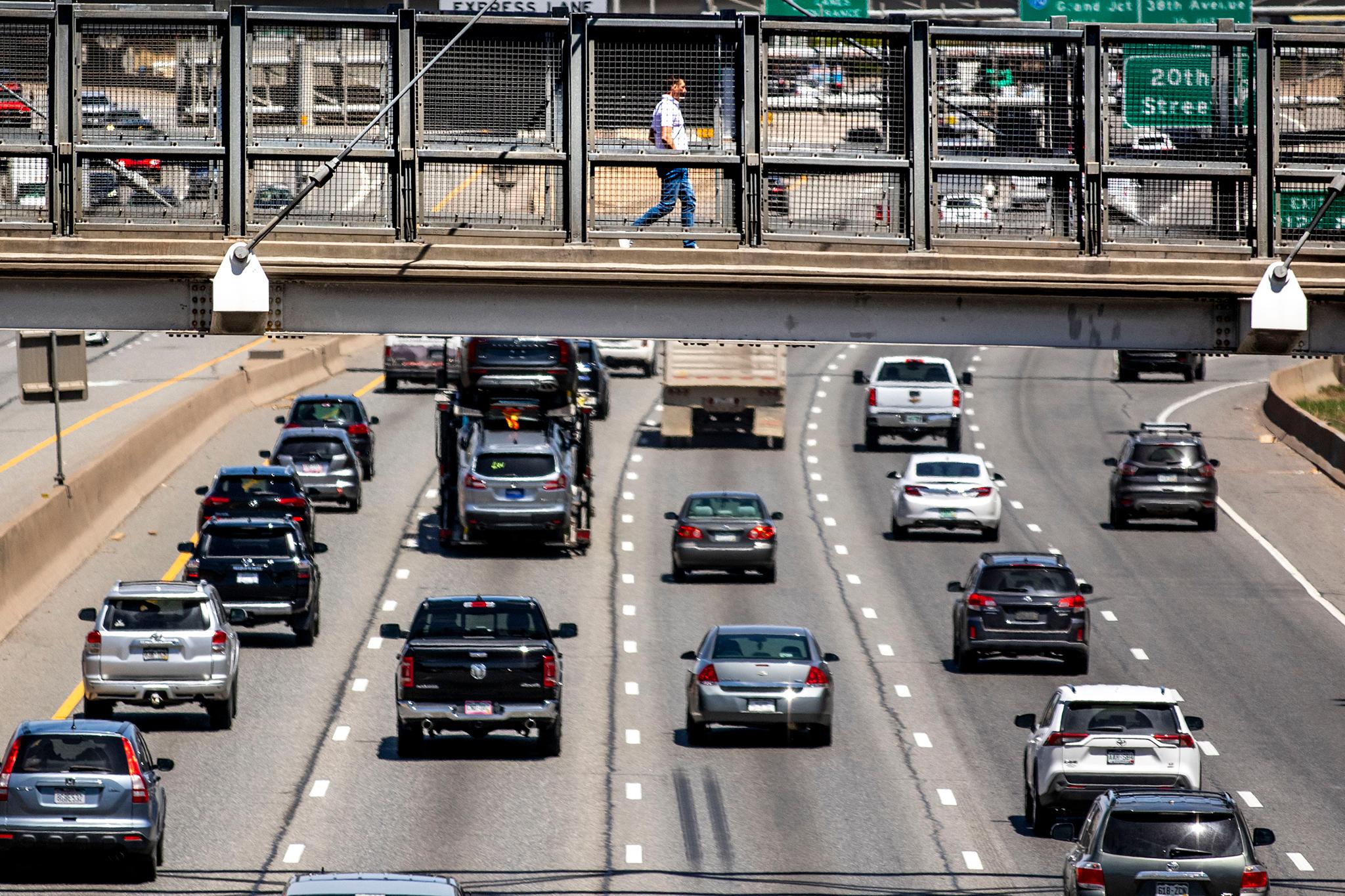When Denverite talked with more than 100 people across the city last summer about what mattered to them, transportation ranked sixth. In the mayoral race, housing, homelessness, affordability and public safety have eclipsed most other issues. But how people get where they need to go, and whether they can do so affordably and safely, touches every aspect of life.
Denver is a city built for cars, in a moment when experts say one of the keys to a sustainable future is to stop driving so many cars. It's a city where people are increasingly priced out, pushed further and further from work, school and other amenities. It's a city where traffic fatalities continue to rise, despite a years-old commitment to bring that figure down to zero. And it's a city in a country with a history of bulldozing minority neighborhoods to build highways, prioritizing cars over people and getting danger and death in return.
Denver is also a city with a lot of people pushing it to do better. Whether it's enough, or fast enough, or done the right way, is a subject of constant debate. But it's a city with passionate volunteer school crossing guards, lower speed limits on neighborhood streets, new bike lanes and lots and lots of ideas on what to do better.
So what do mayoral candidates Mike Johnston and Kelly Brough think about the state of Denver's streets?
In the world of transportation, here are the policy items the two agree on.
While Johnston and Brough vary in some proposals to grow housing, both want to see transit-oriented development, where that growth is centered around public transportation. (Read more about how their plans on housing compare.)
Both have said they support red light cameras and speed cameras, which proponents say make streets safer and can minimize interactions with police.
Both support the VAMOS network, a proposal to create a city-wide network of protected bike lanes by closing a network of neighborhood streets to through-traffic. They also support making the pandemic-era shared streets program permanent, which would make select streets car-free and promote pedestrian and cyclist use.
Both have said they want to fully electrify the city government's vehicle fleets. (Read more about how their plans on the environment compare.)
Both have said they would work to implement the voter approved Denver Deserves Sidewalks ballot measure, which levies a fee on property owners to fund sidewalk improvements. At a mayoral forum on transportation in March, Johnston said he would "do it fast," and that he would work to accelerate the timeline, according to his website. Brough committed to the measure but raised concerns about concrete and cement supply chain issues.
When asked if Denver should pause reconstruction on the I-25 and Broadway ramps and refrain from demolishing homes for the project, both candidates replied "maybe." The city says the construction will ease congestion, but advocates say the plan could make the area more dangerous for pedestrians and cyclists. Plus, one phase of the project would demolish six homes.
Johnston and Brough both said they are against widening Peña Boulevard, which leads to Denver International Airport. Critics of highway widening say they lead to more cars on the road, while officials planning the project say Denver needs a way to handle increasing airport capacity and more lanes could lessen traffic.
Both have said Denver does not need more parking lots.
And they agree on what they think deserves the title of worst intersection in the city: Colorado Blvd. and Colfax Ave.
Brough and Johnston offer two different visions for growing Regional Transportation District (RTD) ridership.
Ridership on public transportation has been down compared to pre-pandemic levels across the country, including in Denver. There's a number of factors, including perceptions of safety, remote work and decreased service.
Johnston has made ridership a center of his transportation plan. His platform includes a plan to partner with businesses and schools to provide discounts on EcoPasses, which give employees unlimited rides on buses and trains. He also hopes the plan would bring more workers back downtown -- though national trends show return to office plans continue to be a challenge.
"I would lead by example, by returning to work in-person and requiring city leadership to work in-person, as well," Johnston said. "I would also work to increase the number of high-quality childcare facilities downtown and incentivize employers to provide childcare on-site, so that parents can come into work without worrying about having access to affordable childcare."
Johnston's plan would then reinvest that EcoPass revenue into RTD, for things like potentially making the 15 and 15L lines free and growing service. Johnston has also said he wants to make RTD free for people under the age of 20 and over the age of 65, but has not elaborated on how. Currently, RTD is considering a pilot program where people ages 19 and younger would ride for free. (In 2022, RTD made fare free during the month of August, which led to a 36 percent increase in ridership compared to August of 2021.)
"We want to make it possible for fewer and fewer people to have to use cars all the time," Johnston told Denverite in an interview. "We want to make it easier for people to use public transit, and to do this link to our plan to help revive downtown Denver."
Brough told 9News she would focus on growing ridership on the hyper-local level.
"We need to engage community to help us determine, neighborhood by neighborhood, how we increase ridership, reduce barriers to multi-modal transportation and make it easier for people to take advantage of climate-friendly, efficient mobility options, including bus, light rail, cycling and walking," she wrote.
Brough and Johnston also differ in how they talk about bike lanes, pedestrian safety and snow plows.
The candidates disagree on how Denver should plow its streets -- something that became an issue this past winter, when roads stayed covered in ice and snow for the longest time since 2012. In Denverite's questionnaire, we asked candidates if the city should increase plowing after snow storms, even if it could mean over budgeting for it. Johnston said yes, while Brough said no.
Positions on pedestrian safety and bike lanes also vary. In 2017, Denver joined cities across the country in committing to Vision Zero, a goal that seeks to bring traffic fatalities down to zero by 2030. And like many other parts of the country, deaths have continued to rise.
Johnston has said Denver should work toward Vision Zero by slowing down traffic, improving walkability, better protecting walkways and building more high comfort, protected bike lanes. In a questionnaire with the Denver Bicycle Lobby, Johnston said he supports adding speed bumps and diverters and removing parking or travel lanes "as context-appropriate" to create more protected bike lanes.
"What becomes clear every time you ride is that not all bike lanes are created equal," Johnston said at a March forum on transportation. "We know that for someone to just paint some lines on the street and expect you to ride next to cars going 50 miles an hour does not mean that you feel safe, and so I think the key question here is how are we creating a network of high comfort bike lanes of lanes that have real protections?"
On Vision Zero goals, Brough has said the city needs a "strategic reset." "It's time to step back, re-evaluate and relaunch," she told 9News, adding in Denverite's questionnaire that she would support better traffic law enforcement in the meantime.
This "reset" is part of the reason why Brough has been more vague on her vision for bike lanes. In the Denver Bicycle Lobby questionnaire, she wrote that she is open to strategies including adding speed bumps and diverters and removing parking or travel lanes, but said she would want to look at the specifics of each situation and "engage local stakeholders."
But in a Denverite questionnaire, she said "no" when asked if Denver needs more bike lanes. She later told Denverite she wants a "reset" on approaches to pedestrian and cyclist safety given the rise in fatalities.
"Are we making the right investments in the right places?" she asked. "I don't know that we're building them [bike lanes] in a way that is improving safety, and my priority is safety when we build those."
And what's left out of the conversation?
"Transportation hasn't really been the sexiest issue in this election for either one of the candidates, which is a bummer because it impacts so many of the other issues that we work on in the city that the candidates do care about," said Molly McKinley, policy director for the Denver Streets Partnership, a transit advocacy group looking to decrease dependency on cars and prioritize infrastructure for people. "I think that transportation is a place where our next mayor can really have a lot of influence."
McKinley said she would like to see both candidates talking more about the use of parking in the city, and how Denver could make better use of lots that stay empty overnight and other public space to serve communities. Conversations around parking often get controversial fast, with the need for safer bike lanes and pedestrian infrastructure meeting business and resident worries about losing spots.
She also wants a mayor to partner with municipalities next door. "People don't just stop their lives at the city and county borders," she said. Most broadly, McKinley said she wants a mayor with big vision, who is willing to take decisive action. To her, Johnston's plans seem more "action oriented," while Brough wants to spend more time planning.
"We spend all of this time planning and not enough time getting things out in the world," she said. "I'd really like to see a mayor who's willing to lead with just getting some things out in the world implemented, and then talking with community to see how things can be updated in a way that better meets people's needs."
Need more help voting? Click here to read the rest of our voter guide.











